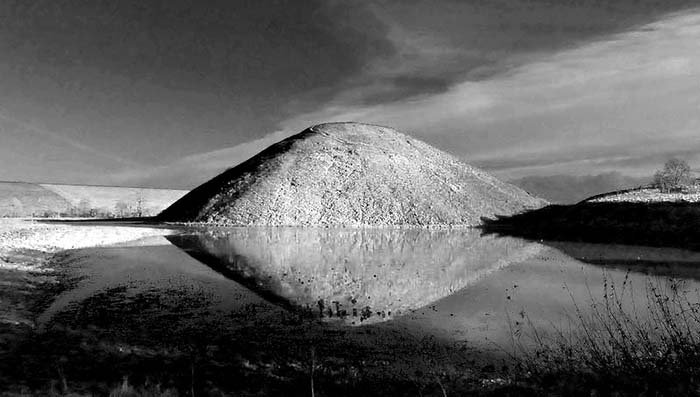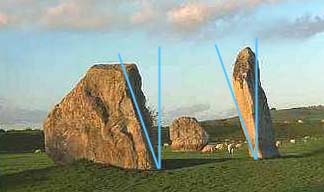THE EFFECT OF WATER ON SACRED SITES.


Water influences the energy field inside sacred sites and the people who use them.
It is one of the most abundant elements on the planet. It is also one of the most mysterious elements on the planet.
This observation was not lost on ancient temple builders. In fact, they embraced it. Every sacred site on Earth either sits above or beside veins or bodies of water. Maps of underground springs, eddies and veins of water below sacred sites such as Stonehenge show how each monument was placed in a certain relationship with the motion of subterranean forces.
Even in places where there are no signs of water this situation exists. The pyramids that sit in the desert of Egypt also lie atop underground rivers; at the Navajo altar in Monument Valley, amid a vast sandstone desert, a stream of water exudes from a large sand dune for a hundred feet before rejoining the desert. Here sits a Navajo sacred site where ceremonies today are performed beside a mature juniper tree. Why should this precious element be so integral to the function of sacred space?
The most obvious answer lies in the end-users of temples: humans. Water is the most abundant element in the human body. It covers two-thirds of it. In this way humans are mirrors of the planet, since two-thirds of the Earth is also covered by water. Naturally, if you’re going to create a sacred space designed to work for the human body it makes sense to incorporate its most abundant element.
Not surprising given how water behaves.
When observing water descending in a spiral down a plug hole, the angle of its descent is roughly 19.47º. The same angle appears in water over horizontal surfaces such as lakes and oceans: the wake created by the bow of a ship, a duck or a stick conforms to this same angle. So, what's with this angle and where does it come from?
Energy upwells from the centre of every planet's core. As it reaches the surface this energy manifests in dramatic form. On Mars it is the biggest volcano in the solar system, Olympus Mons; on Jupiter it is the great red spot; on Uranus it is the dark spot; on Venus it is yet another volcano, and so on.
What links all such manifestations is that they all occur at a latitude angle of 19.47º. At this latitude on the Sun we see major sunspot activity, above and below the equator, and always at 19.47º. This law also exists here on Earth, and it is marked by the most active spot on the planet, the Kilauea volcano, which sits at latitude 19.47º.
If this same angle can be seen in water then we assume water to be some kind of conductor of the forces taking place within the Earth. If so, the use of water as the foundation of sacred sites makes them perfect accumulators and dispensers of earth energy.
Curiously, a large number of standing stones around the world are inclined deliberately at this very same angle. Some are found by themselves, like sentinels marking a fertile spot. Others are incorporated into the fabric of major stone circles. Before risk-averse lawyers instructed English Heritage to straighten one of Avebury's prominent stones, its angle of incline was 19.47º. Looking at it today, its alignment actually feels artificial, and not without cause because this gnomon stone once mirrored the angle of its adjacent lozenge stone.

The Cove at Avebury before the gnomon stone (right) was straightened. The angle of recline is 19.47º.
In temples and sacred sites, water becomes highly charged due to its interaction with magnetism, which is also a fundamental force at every sacred site. Magnetism is know to spiral inside sacred sites, and the swirl motion of energy in water generates an electro-magnetic field, further enhancing the temple and its affect on people.
The relationship between sacred sites and the sanctity of water is best seen in southern Britain. Silbury hill, Europe’s tallest conical pyramid, is situated on a plain that was deliberately shaped by hand, and the purpose behind such a massive endeavour becomes obvious every February 2nd.
Looking like the belly of a pregnant Earth mother, the field surrounding Silbury is fed by numerous local springs that every year burst to life on the Celtic feast of Imbolc, the Christian Candlemass. As the water accumulates around the base of the mound, from the air, the figure of a pregnant woman slowly comes to life.
As the springs bestow their life-affirming qualities upon the land so they connect and revitalize the hundreds of mounds, stone circles and other oracles in this special corner of the world.
Like the dance between the Moon and the tides, the relationship between water and temples is at once energetic, cyclical and symbolic.
© Freddy Silva. No unauthorized reproduction.
Return to Water.

Dowsing map of Stonehenge shows the relationship of stones to underground veins and vortices of water.